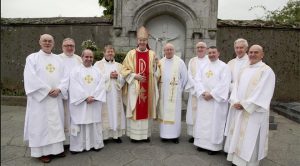
By Ann Marie Foley - 10 May, 2017
Almost one third of priests in the Kildare and Leighlin Diocese are over the age of 75. The priest to parishioner ratio has almost halved in the last ten years. Lay parish teams, permanent deacons and priests from religious orders and from abroad have been taking up the slack, but now the diocese needs to plan for the future.
This is according to Bishop Denis Nulty, who addressed all parishes last weekend with a pastoral letter in which he thanked everyone involved in diocesan life and said that the level of volunteerism is “staggering”.
“One major challenge is the falling number of priests. At present, there are 90 priests ministering in our diocese; 27 of them are over 75. This stark figure reminds us that a radical reappraisal of what a parish community should be, how it should be organised, co-ordinated, funded and ministered, is necessary,” he stated in the letter.
On Good Shepherd Sunday, traditionally known as Vocations Sunday, he announced plans for a consultation with priests and parishes to decide on a way forward.
All the priests in the three deanery areas will meet during May. On 20 June, priests, involved lay people from each parish, religious and permanent deacons will gather at Mount St Anne’s retreat centre. There will be further meetings of priests and lay people in each deanery area into the autumn, to which all parishioners are invited.
Topics for the meetings include:
• what people want from their Church, their parish and their diocese in 2017
• appointment of priests
• outreach to families
• chaplaincy in schools, hospitals, nursing homes, prisons, etc.
• outreach to minorities and those on the margins
• permanent diaconate
• parish and diocesan resources
In the pastoral letter Bishop Nulty stated that there will be changes for priests in trying to find new ways to serve their people. The diocese must also consider if it will welcome more priests from abroad. Also up for consideration is whether priests need to focus more on “mission” than “maintenance”, which could be delegated more to parish teams.
He said that lay people will see changes to Mass times or a revision of funeral, wedding and baptism times.
The ongoing viability of some churches and whether they should have a weekly mass or not will be questioned.
Also up for consideration is whether lay leadership and chaplaincy might become the norm in some parishes, schools, hospitals and prisons.
“On this Vocations Sunday I encourage you to join your fellow parishioners to participate in these upcoming meetings, to offer your opinion and to make a contribution in shaping our parish and diocesan Church for the future. As we face these changes and challenges I thank you for what you have already achieved and pray for the courage of the Holy Spirit to guide all of us as we embark on this journey together,” he concluded.
In preparing for the Bishop’s Ad Limina Apostolorum (visit to Rome to meet with Pope Francis) last January, statistics were compiled. They show that there was one priest to every 1,865 people in the diocese in 2006 and one priest to 3,462 people in 2016.
There were 110 priests in active ministry in 2006, and ten years later there were 73 active diocesan priests, an additional 12 from religious orders and 5 more from foreign dioceses.
There were no permanent deacons in 2006, with eight in 2017 and an additional four in formation. Lay people serve on 44 parish pastoral councils, 33 parish baptism teams, 21 parish liturgy groups, 56 parish finance committees and 11 parish funeral ministry teams, of which 7 teams were recently trained.
A further 1,181 people serve voluntarily on primary school boards of management and 146 people serve as parish safeguarding representatives.
The Kildare and Leighlin Diocese has 56 parishes and 117 churches.